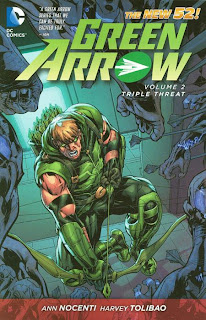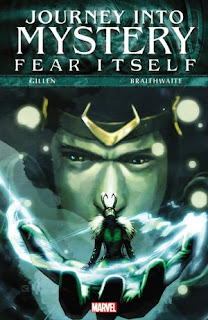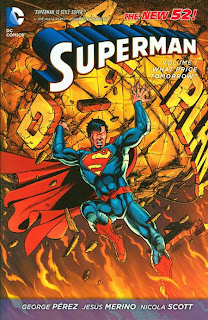 I've been pretty high on Green Arrow these past couple of days, having enjoyed two especially good episodes of the CW's Arrow, "The Odyssey" and "Dodger." (Even if "Dodger" is the worst. supervillain. name. ever.) Ann Nocenti's Green Arrow Vol. 2: Triple Threat does nothing to hurt my enthusiasm for Arrow, but certainly if DC Comics wants to attract Arrow fans, Jeff Lemire and Andrea Sorrentino's new run can't come soon enough.
I've been pretty high on Green Arrow these past couple of days, having enjoyed two especially good episodes of the CW's Arrow, "The Odyssey" and "Dodger." (Even if "Dodger" is the worst. supervillain. name. ever.) Ann Nocenti's Green Arrow Vol. 2: Triple Threat does nothing to hurt my enthusiasm for Arrow, but certainly if DC Comics wants to attract Arrow fans, Jeff Lemire and Andrea Sorrentino's new run can't come soon enough. Nocenti's stories here are chaotic and confusing, as is Harvey Tolibao's artwork. Moreover, as loosely-defined as Green Arrow Oliver Queen is after just one previous volume (JT Krul, Dan Jurgens, and Keith Giffen's Green Arrow: The Midas Touch), I don't think Nocenti fundamentally understood the new Green Arrow in these pages, or she took him in a different direction than the previous writers intended, which also dampened my enjoyment of this book.
[Review contains spoilers]
The New 52 Green Arrow is more billionaire playboy than the old DC Universe's grizzled activist, and there's nothing wrong with that given how down and dark the pre-Flashpoint Green Arrow had become. But though Krul, Jurgens, and Giffen's Oliver Queen was young and irreverent, he wasn't completely disinterested in his late father's Queen Industries; in issue #3, he challenges the company to create more meaningful products, and in issue #4, he suggests his assistant Jax begin a video games division at Queen's Q-Core (for the purposes of helping Green Arrow, but still, it's a project). The reader understood that Oliver shirked his Queen Industries as a ruse, all the better to mask his use of Q-Core's technology for fighting crime.
But the first pages of Nocenti's Triple Threat have Oliver musing how he hates memos, how running a tech company should be "fun," and how he wishes he could live solely as Green Arrow. If the third part is on character, the first two suggest, disturbingly, that Nocenti has believed the lie; rather than portraying Green Arrow as a billionaire pretending to be a playboy to mask his superheroics, Nocenti's Green Arrow is an actual billionaire playboy superhero -- a spoiled rich kid who fights crime rather than live up to his responsibilities. This might be worthy of exploration, but Nocenti's Oliver is irreverent to the point of unlikability -- Nocenti later blames Oliver's decision to quit his company on mind control, but the damage to the reader's opinion of the character is well done by that point.
The greater difficulty with Triple Threat, however, is the clumsiness of the storytelling. The first four pages of the book are Green Arrow standing around talking to himself, including quoting lines from King Lear, and then that the story's villain just so happens to turns out to be named "Leer" and have three daughters. Why exactly Leer wants his daughters to kidnap Green Arrow is never quite clear, nor -- after Arrow escapes with one of Leer's daughters -- is it why Arrow suddenly seems more concerned with capturing Leer's escaped mutant bear than stopping Leer himself.
There's also often a disconnect between Nocenti's script and Harvey Tolibao's art. Tolibao, though an experienced Marvel artist, struggles from the beginning, as when Green Arrow and Skylark fight in the first issue and often seem to be looking past one another or standing back to back. Toward the end of the second issue, Nocenti's dialogue has Leer telling his daughters to go after the escaping Green Arrow, while Tolibao's art has Leer dragging one of the daughters backward. In the third issue, Green Arrow spits in a saloon, seemingly for no good reason, and only on the next page does Tolibao reveal the "No spitting" sign, totally botching the joke; Nocenti doesn't make it clear, however, why Arrow should want to insult the saloon patrons anyway, so the confusion just compounds.
The next chapter is a one-shot story with a guest artist, and then in the final three issues, Oliver flies to China to try to bargain back shares of his company from corrupt businessman Fang. The details, again, get muddled -- Fang seems to want Queen's facial recognition technology to get out from under the strict government, which wouldn't seem such a bad goal, but Oliver balks, Fang's thugs attacks him, and later Oliver plans to return as Green Arrow just to beat up Fang for having attacked him. When Oliver goes back, Fang suddenly has the ability to resurrect his dead relatives for protection (despite that he didn't know Green Arrow was coming), and Arrow has to lure these spirits to another graveyard where the bodies of ancient warriors just so happen to have recently been unearthed, so the two groups of spirits can fight.
Though having Green Arrow battle to regain Oliver Queen's company is a better use of the character, Nocenti gives Arrow an "arrow gun" for a good part of the arc instead of a bow and arrow, which feels a little far from the character in just his second volume. The Chinese superhero Suzie Ming that Nocenti introduces serves mostly for exposition (it's a shame things didn't line up so Nocenti could use Katana here). On top of Jax and the character Naomi, Nocenti gives Green Arrow a third handyman/jack-of-all-trades, Jimmy Crew, and it's rather astounding that Nocenti doesn't have Oliver blink or even question that Naomi has revealed his secret identity to another person.
I haven't read anything else by Ann Nocenti, whom I know to be a popular Marvel writer, and I can't speak for her other work. I do, however, have good faith in Jeff Lemire after his Frankenstein and Animal Man, and so I'll simply say that I'm looking forward to the Green Arrow/Hawkman/Deathstroke crossover in the next Green Arrow volume, and then I'll be glad when Lemire's stories start.
Aside from all Green Arrow: Triple Threat's other problems, the paper here is pretty thin, perhaps to fit in
[Includes original covers (maybe one variant I couldn't place), sketches by Totlibao and Freddie Williams]
Next week, the second volume of the New 52 Batwoman; tomorrow, the next in our series of Saga of the Swamp Thing reviews. Thanks!





























































